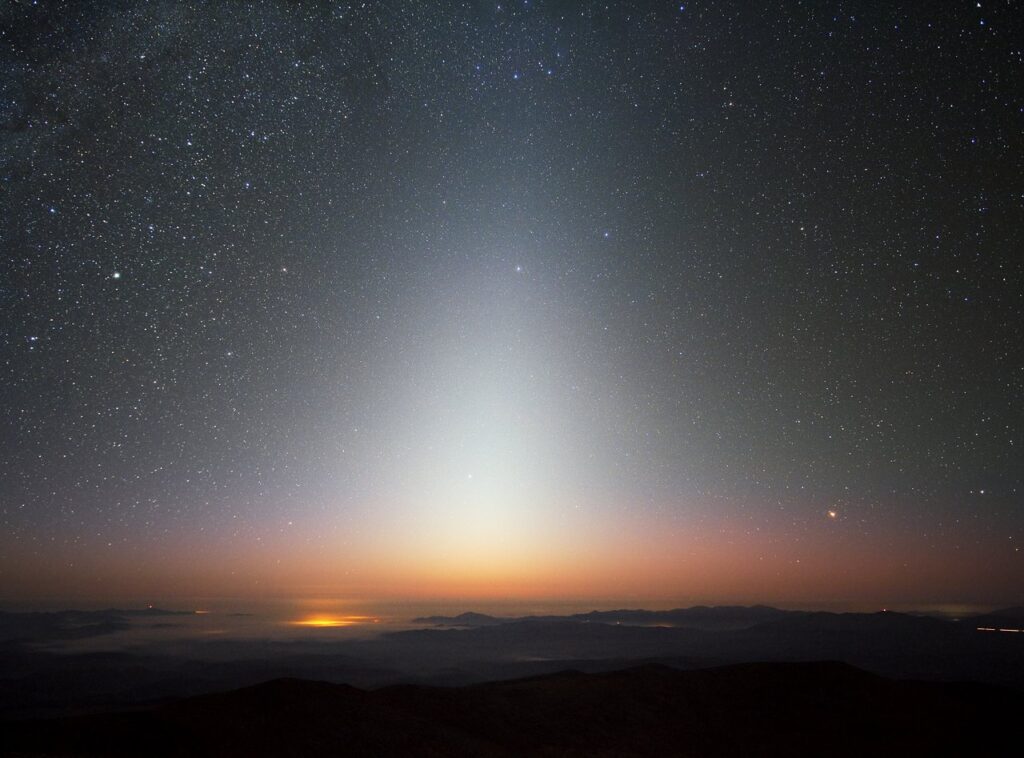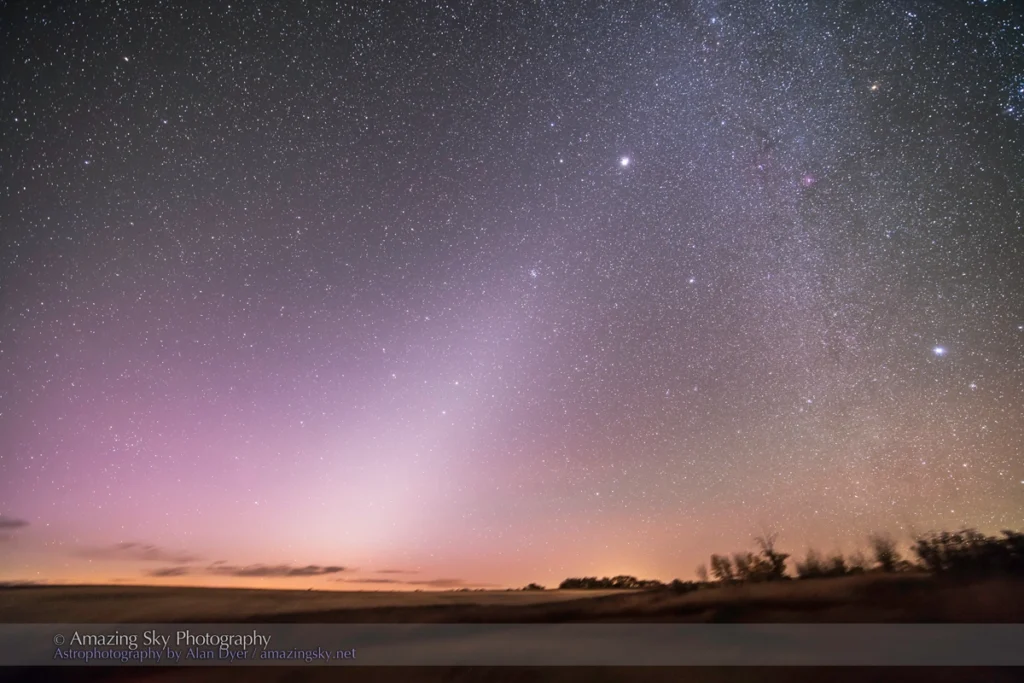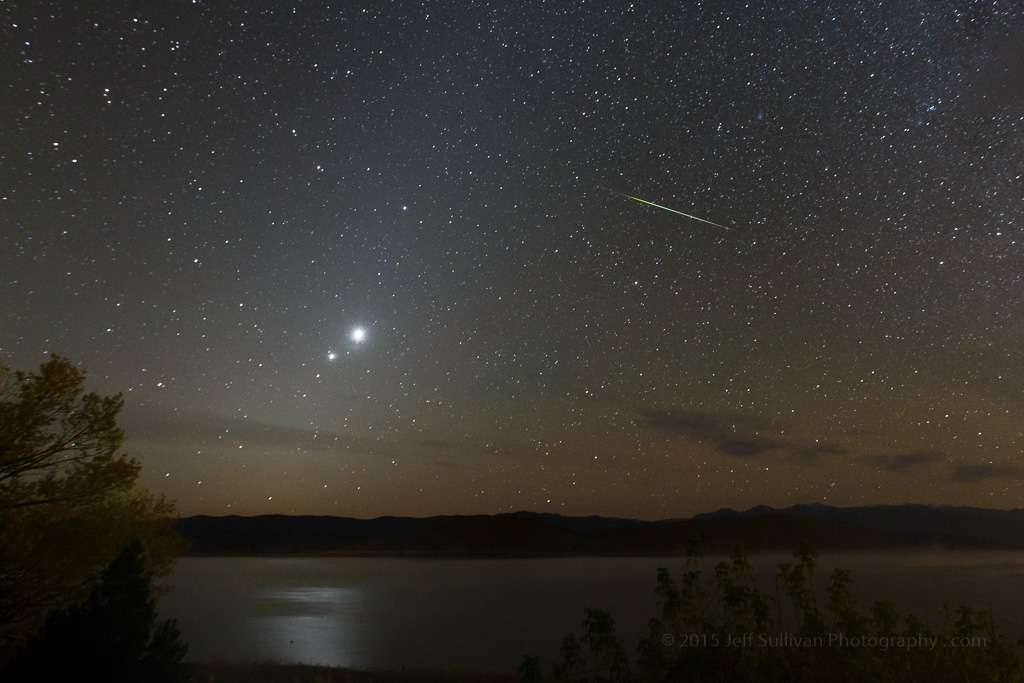“What do astronomy and astrology have in common?” It is not so easy to answer this question. The best answer is terminology. Indeed, astrologers use the same names for the planets, the Sun, the Moon, and some constellations that are historically called zodiacal in their “predictions.” These constellations are positioned along the ecliptic, which is an imaginary projection of the Earth’s orbit onto the celestial sphere. In fact, the names are the only thing that matter here: astrological treatises do not mention constellations, but rather sections of the ecliptic, conventionally divided into 12 equal parts of 30° each. However, the word “zodiacal” has also found its way into astronomy, as it was used to describe an interesting celestial phenomenon that many people have seen but often did not even know existed.

If you go somewhere outside the city, as far away from artificial lighting as possible, on a cloudless and moonless evening in late February or early March and watch the evening star fade, you will notice that at some point the twilight band over the western horizon begins to fade unevenly: In one place, it leaves a ghostly light triangle, the wide base of which is located approximately at the point of geodetic west, and the top stretches across the night sky almost to the remarkable starry cluster of the Pleiades. An attentive observer will also see that this triangle is “tied” to the stars and participates in the daily rotation of the sky, i.e. it is not an atmospheric phenomenon. Its centerline coincides with the ecliptic. A similar effect, but before dawn, also occurs in our latitudes in October (but quickly disappears in the morning twilight).
The clarification “in our latitudes” is extremely necessary here: if you move a few degrees “up” from northern Ukraine (to Latvia or northern Belarus), the described phenomenon will become practically unobservable. On the contrary, at the latitude of Crimea during the specified periods of the year, it is quite visible, and the closer to the equator, the better. Starting in North Africa, it can be observed almost all year round, and in the latitudinal range between the northern and southern tropics, it is sometimes simply striking. It was there that Europeans, who made the first long-distance sea voyages in the era of great geographical discoveries, met it. Meanwhile the medieval Arabs knew about the “false dawn” (as they called it) at the beginning of the last millennium. There is evidence that this phenomenon was also known to the ancient Chinese and Mesoamerican civilizations. Nowadays, the name “zodiacal light” has been assigned to it.
Discovery and research
The first descriptions of zodiacal light in European science, made in 1661, belong to the English priest Joshua Childrey. Since he had never left the British Isles for most of his life, his research was based largely on descriptions made by Edmond Halley, a famous astronomer of the time, after whom the famous comet was later named. This versatile scientist spent a lot of time in tropical latitudes and left many descriptions of the southern sky and the phenomena he saw there.
The French astronomer of Italian origin Giovanni Cassini made more detailed studies of zodiacal light, summarizing them in his work of 1683. He was the first to notice that the bright spot stretches on both sides of the Sun and is shaped like a rhombus, with its major axis lying on the ecliptic. Cassini also suggested that this phenomenon is associated with the reflection of sunlight from interplanetary dust particles. According to other sources, this idea belonged to the astronomer’s friend, the Swiss mathematician Fatio de Duillier.

The next stage in the study of zodiacal light was associated with the emergence of sensitive photo emulsions and wide-angle lenses that made it possible to take photographs of large areas of the starry sky. In such images, astronomers saw that the “excess light” is not limited to the rhombus around the Sun — it stretches in a strip several degrees wide along the entire ecliptic, which widens slightly and becomes brighter at the antisolar point. This formation is called a “counterglow”. Later, scientists learned that it is of a slightly different nature than zodiacal light and is caused by the Earth’s “gas tail” — a plume of matter “knocked out” of the Earth’s atmosphere by the solar wind (comet gas tails have the same origin).
In fact, observations made it clear that the surface brightness of zodiacal light should increase up to the very edge of the solar disk, but it was not possible to confirm this for a long time until, on June 19, 1936, during a total eclipse of the Sun, Japanese astronomer Minoru Gonda saw a dim orange glow around the solar corona, which had the already known shape of a diamond. Subsequent spectral studies showed that it was emitted by incandescent dust particles similar in chemical composition to Earth’s silicate rocks.
With the advent of the space age, the time for polarization research came. The phenomenon of polarization of electromagnetic waves — the change in their properties after reflection from most surfaces or passing through some crystals — was discovered in the early nineteenth century, but in the case of zodiacal light, the difficulty was that its radiation was affected by the effects associated with its passage through dense layers of the atmosphere. Polarimeters installed on artificial Earth satellites and the Skylab manned station confirmed that in this case we are indeed dealing with the reflection of sunlight from small dust particles in outer space.
In 1972, the interplanetary dust detector installed on the Pioneer 10 probe registered exactly the same decrease in the concentration of particulate matter with distance from the Sun as predicted by models based on the analysis of the brightness of zodiacal light. The nature of this phenomenon could be considered discovered, but questions remained about its origin.
The source of interplanetary dust
The first of these questions is why interplanetary dust has not completely fallen on the Sun and planets over the billions of years of the Solar System’s existence? The answer is simple: it falls on them all the time (60 to 100 tons of substance from space falls on the Earth alone every day), but at the same time it is constantly replenished. And its source is small bodies, such as comets and asteroids. They have low gravity, which allows their small particles to easily “escape” into the surrounding space.

Since the main “part” of zodiacal light is concentrated near the ecliptic, it would be logical to assume that the cosmic dust that creates it is formed during the collision of asteroids — they also mostly move close to the plane of planetary orbits. Meanwhile, the orbits of comets belonging to the so-called Jupiter family (with periods of orbit around the Sun of less than 20 years) also “gravitate” to the same plane. Although their total number is smaller, they are much more active in “pollinating” space — they don’t even need to collide with anything.
Further research has shown that this is indeed the case. Scientists were even able to distinguish two components in the zodiacal light: “asteroid” (closest to the ecliptic) and “comet” (more distant and concentrated around the Sun). These conclusions were confirmed by analyzes of the substance delivered to Earth by the Stardust probe, as well as data obtained by the European Rosetta spacecraft, which in 2014-2016 approached the comet 67P/Churyumov-Gerasimenko to investigate it.
Calculations show that to create the required level of brightness of zodiacal light, quite a bit of matter is needed: if it were created by dust particles of 1 mm in size, which have the same average reflectivity (albedo) as the surface of the Moon, the distance between two neighboring particles in the vicinity of the Earth’s orbit would have to be 8 km. Of course, closer to the Sun, their concentration increases, but they still do not pose a significant threat to interplanetary vehicles.

What is the fate of a “speck of dust” ejected from the surface of a comet or asteroid? It depends on its size. If it is less than one micrometer, sunlight will exert considerable pressure on the particle, gradually accelerating it and “pushing” it out of the sphere of gravity of our luminary. Grains of sand ranging in size from 1 micron to 1 mm behave quite differently. The same solar photons hit them slightly in front of the direction of orbital motion and transmit a weak impulse, which accumulates over time and slows the particle down. It moves into an orbit closer and closer to the Sun and eventually falls into the luminary (unless it first encounters a planet). This “photon deceleration” is called the Pointing-Robertson effect, in honor of the physicists who first predicted it theoretically.
The beauty of the southern sky
In 2007, Queen’s guitarist Brian May decided to complete his doctoral thesis entitled “Investigating Radial Velocities in the Zodiacal Dust Cloud” — 36 years after he abandoned it to pursue a career in music. To his great surprise, this scientific topic has not lost its relevance, and soon the scientist, better known as a musician, successfully presented it.
Even this fact clearly shows how little we know about zodiacal light. Changes in the shape of the interplanetary dust cloud over time, the dependence of its concentration and brightness on comet flybys, the phase of solar activity, and its possible connection with higher-order structures such as interstellar dust clouds — all of these remain virtually unexplored. Recently, research in these areas has intensified significantly, and even astronomy enthusiasts are making certain contribution. This phenomenon is also considered to be very “photogenic” when captured in wide-angle photographs of the southern sky. Often, bright planets are visible against its background, and sometimes comets approaching the Sun are visible.
Unfortunately, the conditions for observing zodiacal light from the territory of Ukraine are still quite unfavorable. But for those who find themselves closer to the equator for at least a short time, we strongly advise you not to miss the opportunity to admire the ghostly light triangle that adorns the tropical starry sky after evening twilight. However, it is difficult to see it on moonlit nights or when it is projected onto the shining band of the Milky Way.

